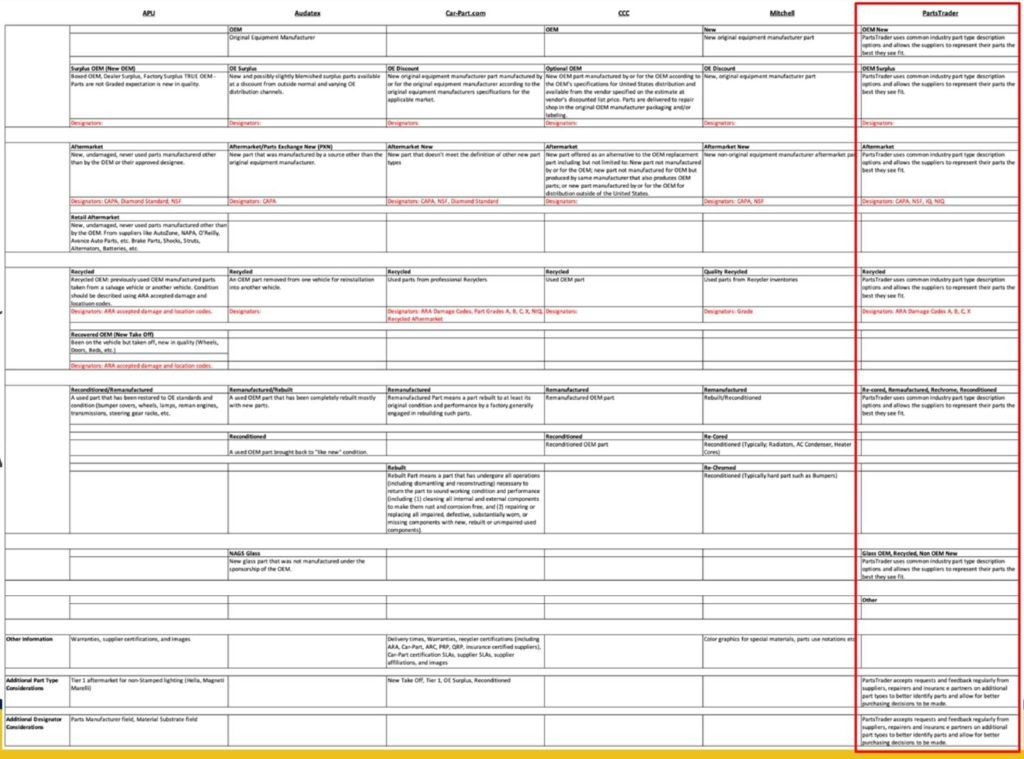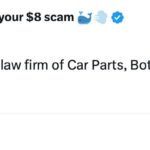The car parts trading landscape is complex, with various platforms offering an array of parts categorized in distinct ways. Recent discussions at the Collision Industry Conference (CIC) highlighted the critical need for clarity and consistency in parts definitions, revealing how different platforms like APU, Car-Part.com, and PartsTrader classify automotive components. For Car Parts Traders and repair professionals, understanding these nuances is paramount for efficient procurement and ensuring accurate repairs.
This article delves into the definitions shared at the CIC, providing a comprehensive guide to navigating the terminology used by leading car parts trading platforms. By understanding these classifications, businesses can optimize their parts sourcing strategies and minimize discrepancies when ordering ostensibly similar parts across different platforms.
Decoding Car Part Definitions Across Platforms
The Parts and Materials Committee at the July CIC session presented a crucial slide outlining the part definitions used by different platforms. These definitions, while aiming to categorize parts effectively, reveal potential variations that repairers and car parts traders must be aware of.
APU: A Detailed Breakdown of Part Categories
APU’s classifications offer a granular view of the car parts spectrum, distinguishing between various types of OEM and aftermarket components:
Surplus OEM (New OEM): Defined as authentic OEM parts, these are “boxed OEM,” “Dealer Surplus,” or “Factory Surplus.” Crucially, these are considered “TRUE OEM” parts, expected to be new and of the highest quality, without grading variations. Eric Marrello, APU director of sales, emphasized that Surplus OEM parts are indeed new, still “in the box,” and sold by a dealer or affiliate, complete with the OEM warranty.
Aftermarket: This category encompasses new, undamaged, and unused parts manufactured by companies other than the original equipment manufacturer (OEM) or their designated suppliers. These parts often carry designators such as CAPA, Diamond Standard, or NSF, indicating certification and quality standards.
Retail Aftermarket: A subset of aftermarket parts, Retail Aftermarket parts are also new, undamaged, and unused but are sourced from well-known retail suppliers like AutoZone, NAPA, O’Reilly, and Advance Auto Parts. This category typically includes maintenance and repair essentials such as brake parts, shocks, struts, alternators, and batteries.
Recycled (Recycled OEM): These are used OEM parts salvaged from vehicles, either from salvage yards or other vehicles. APU emphasizes that the condition of recycled parts should be meticulously described using ARA (Automotive Recyclers Association) accepted damage and location codes, ensuring transparency about the part’s history and condition.
Recovered OEM (New Take Off): This category refers to parts that were originally installed on a vehicle but were removed shortly after, essentially “new in quality.” Common examples include wheels, doors, and beds. Similar to Recycled parts, Recovered OEM parts utilize ARA accepted damage and location codes for condition assessment.
 Car Parts Trader Platform Definitions: A comparison of OEM, Aftermarket, and Recycled part classifications across APU, Car-Part.com, and PartsTrader, as presented at the Collision Industry Conference.
Car Parts Trader Platform Definitions: A comparison of OEM, Aftermarket, and Recycled part classifications across APU, Car-Part.com, and PartsTrader, as presented at the Collision Industry Conference.
Reconditioned/Remanufactured: These are used parts that have undergone a restoration process to meet or exceed original equipment (OE) standards and condition. Examples include bumper covers, wheels, lamps, and remanufactured engines, transmissions, and steering gear racks.
The distinction between Surplus OEM and Recovered OEM arose from customer feedback about a decade ago, Marrello explained. APU recognized the need to differentiate between truly new, boxed parts and those taken off new vehicles, highlighting that Recovered OEM parts, while of high quality, are not the same as Surplus OEM.
David Willett of ProSight Specialty Insurance added another perspective on “takeoff” parts, mentioning the “dealer trade” phenomenon where new car buyers immediately replace components like tires. These practically brand-new parts enter the market, representing a distinct category within the car parts trade.
Interestingly, APU and its sister company Audatex, both under the Solera umbrella, present some differences in part classifications. While Audatex recognizes both OEM parts and OE Surplus, their definition of OE Surplus is broader, including “New and possibly slightly blemished surplus parts available at a discount from outside normal and varying OE distribution channels.” Audatex also lacks the Recovered OE category but offers a more segmented approach to refurbished parts, distinguishing between Remanufactured/Rebuilt and Reconditioned parts.
Car-Part.com: Aligning with Federal Standards
Car-Part.com’s definitions reflect an emphasis on industry and federal standards, providing a streamlined categorization for car parts traders:
OE Discount: This category denotes new original equipment manufacturer parts. These parts are manufactured by or for the OEM, adhering to the OEM’s specifications for the relevant market.
Aftermarket New: This is a broad category for new parts that do not fit into other new part type definitions. Like APU, Car-Part.com includes designators such as CAPA, NSF, and Diamond Standard to indicate certified aftermarket parts.
Recycled: Car-Part.com defines recycled parts as used components sourced from professional recyclers. They utilize ARA Damage Codes and Part Grades (A, B, C, X, NIQ) to describe the condition of these parts. Notably, Car-Part.com also acknowledges “Recycled Aftermarket” parts within its network, catering to specific demands, although these are not typically included in their marketplace for professional repairers. CEO Jeff Schroder mentioned that while suppliers could classify parts as “new takeoff,” Car-Part.com would categorize them under recycled parts.
Remanufactured: Car-Part.com’s definition of remanufactured parts aligns with federal registry guidelines, defining them as parts rebuilt to at least their original condition and performance by a factory specializing in such processes.
Rebuilt: Similarly, “rebuilt parts” adhere to federal guidelines, referring to parts that have undergone comprehensive operations to restore them to sound working condition and performance. This includes cleaning, inspecting, and replacing worn or defective components with new, rebuilt, or unimpaired used components.
Schroder highlighted Car-Part.com’s integration with Mitchell and their use of CIECA standard part codes for seamless data exchange. He also pointed out their support for the CIECA BMS standard, enabling two-way parts communication, contrasting with the older unidirectional CIECA EMS format.
PartsTrader: A Market-Driven Approach
PartsTrader adopts a more open approach, allowing suppliers greater flexibility in categorizing their parts within common industry descriptions:
OEM New: PartsTrader utilizes standard industry part type descriptions, empowering suppliers to represent their parts as they deem most appropriate.
OEM Surplus: Similar to OEM New, suppliers have the autonomy to classify their “OEM Surplus” parts using industry-standard descriptions.
Aftermarket: PartsTrader’s “Aftermarket” category also relies on industry-standard descriptions, with suppliers indicating designators like CAPA, NSF, IQ, and NIQ where applicable.
Recycled: For recycled parts, PartsTrader employs industry-standard descriptions and includes ARA Damage Codes (A, B, C, X) to provide condition details.
Re-cored, Remanufactured, Rechrome, Reconditioned: This broad category illustrates PartsTrader’s inclusive approach, again relying on common industry descriptions and supplier discretion for accurate representation.
Ken Weiss, Co-Chairman of the Parts and Materials Committee, suggested that PartsTrader’s philosophy is rooted in the belief that the marketplace itself, through feedback and interactions, will drive accuracy and clarity in part categorization. While PartsTrader provided input on their categories, they opted not to participate directly in the CIC panel discussion.
Implications for Car Parts Traders and Repair Professionals
The variations in car part definitions across these leading platforms underscore the importance of meticulous attention to detail when procuring parts. For car parts traders, understanding these nuances is crucial for accurately listing and selling inventory, ensuring transparency and customer satisfaction. Repair professionals must also navigate these definitions to order the correct parts, manage costs effectively, and maintain repair quality.
The discussions at CIC highlight an ongoing industry effort to standardize and clarify car part terminology. As the car parts trading ecosystem evolves, continued dialogue and collaboration are essential to bridge the gaps in definitions, fostering a more efficient and transparent marketplace for all stakeholders.
More Information:
CIC, July 22, 2020
Images:
Vehicle doors are shown. (Traimak_Ivan/iStock)
This graphic from the Collision Industry Conference Parts and Materials Committee outlines part category definitions outlined by estimating and part procurement systems. (Provided by Collision Industry Conference)
Share This:
if ( function_exists( ‘ADDTOANY_SHARE_SAVE_KIT’ ) ) { ADDTOANY_SHARE_SAVE_KIT(); } ?
